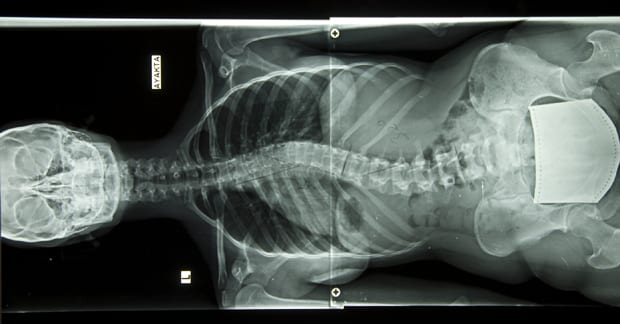Scoliosis is a curvature of the spine that gives it either a “C” or an “S” shape when looking at the person from behind. I’m sure you’ve noticed when you’re at a beach, at a swimming pool, or walking in an airport, some people have a high shoulder, walk with a bit of a limp if one leg is short, or may have a shoulder blade that sticks out more than the other. Scoliosis often develops for unknown reasons (hence the term, “idiopathic”) around ages ten or eleven years and can progress, not change, or (less often) improve up to age 16 to 18. During these 4-6 years, the time when the adolescent is rapidly growing, the curve often worsens without any intervention but few studies have looked at what types of treatment or combinations of treatment work the best, especially non-surgical methods.
A 2006 study looked at the response to non-surgical treatment using conventional medical treatment (MT) vs. conventional MT plus chiropractic, as well as conventional MT and “sham” (fake) chiropractic treatment. This is a pilot study using a small population of patients in order to determine if a larger scale study would be important to run (which was determined to be the case).
The conventional medical treatment approach included two groups: one in which participants wore a back brace and one in which they did not. The chiropractic treatment group received spinal manipulation using “diversified technique” in which the patient is treated while lying on their stomach, sides, and back and the type of manipulation used was the thrust type where the “cracking” sound occurs (which is caused by the release of gas from the joint capsules and is technically called “cavitation”). Adjustments were applied to the regions determined by the chiropractor as requiring treatment by using palpation (touch) methods, postural examination, range of motion, and x-ray. All chiropractors involved in the study also completed six hours of training to assure consistent and similar approaches were used with each patient. Treatments were administered (determined by a survey of many chiropractors) at 3x/week for a month, 2x/week for a month, 1x/week for a month, and 2x/month for 3 months or as needed for a total of 6 months. The “sham” or fake chiropractic treatment used the same treatment frequency and similar positioning of the patient but purposely did not obtain a joint cavitation or “crack” but still seemed “real” to the patient.
The primary outcome used to determine “success” was a reduction of the scoliosis curve measured on x-ray after six months. Using the standard medical model, those with curves of 20-25 degrees require careful observation, curves 26-40 degrees are potential candidates for bracing, those greater than 40 degrees are potential candidates for surgery, and an increase in curve by more than 5 degrees measured twice a year or every 6-months is considered failure.
The results were interesting. Of those who received only conventional medical treatment, none improved and one failed. The same occurred in the conventional MT plus sham/fake chiropractic group. NO ONE failed and one improved in the chiropractic treatment plus MT group making it the only successful non-surgical treatment approach in the study. The preliminary findings from this study are huge! Chiropractic treatment in this group of adolescent children was determined to be THE ONLY non-surgical approach that had the ability to maintain (not allow the curve to progress) or even better, improve the curve!





